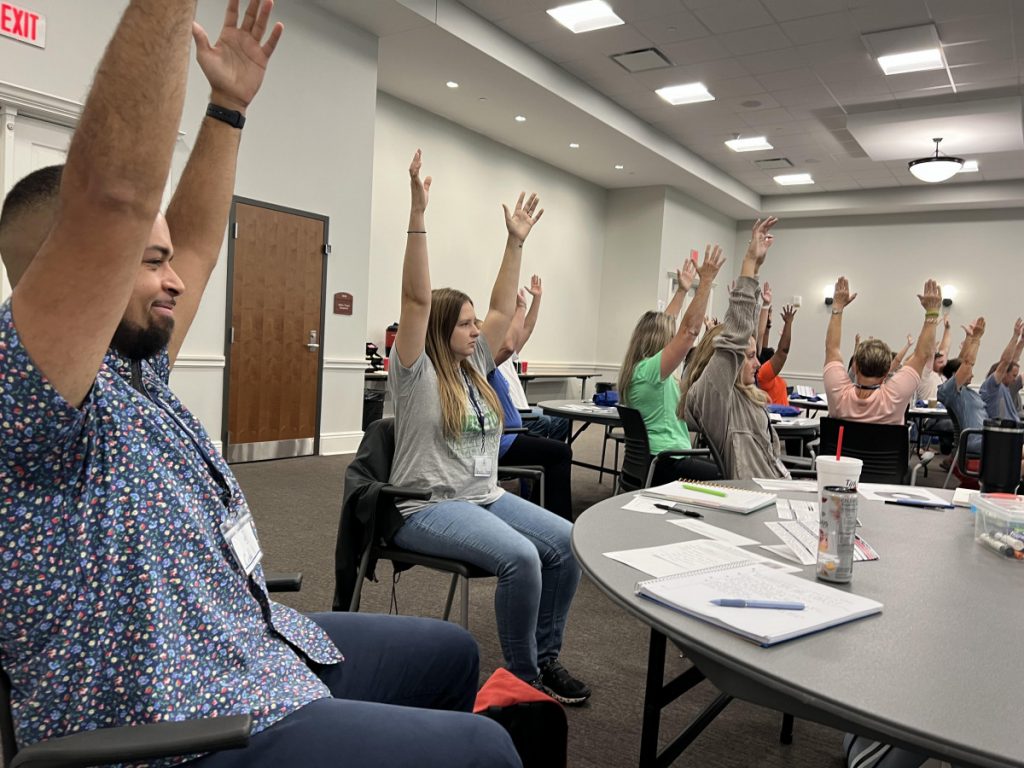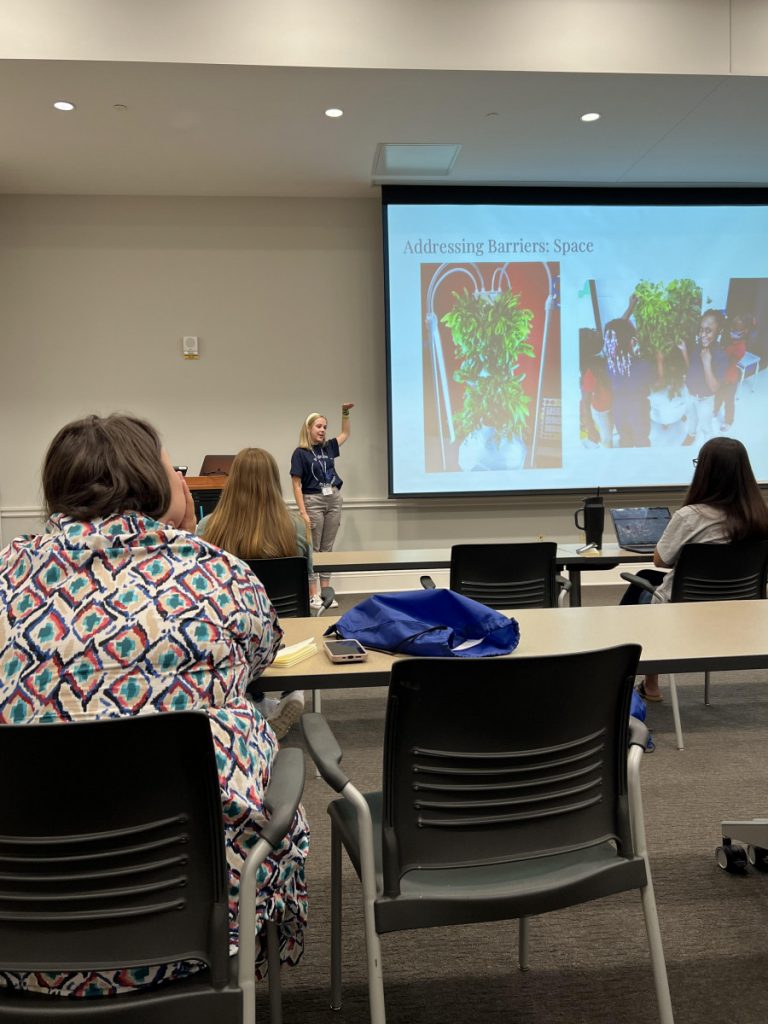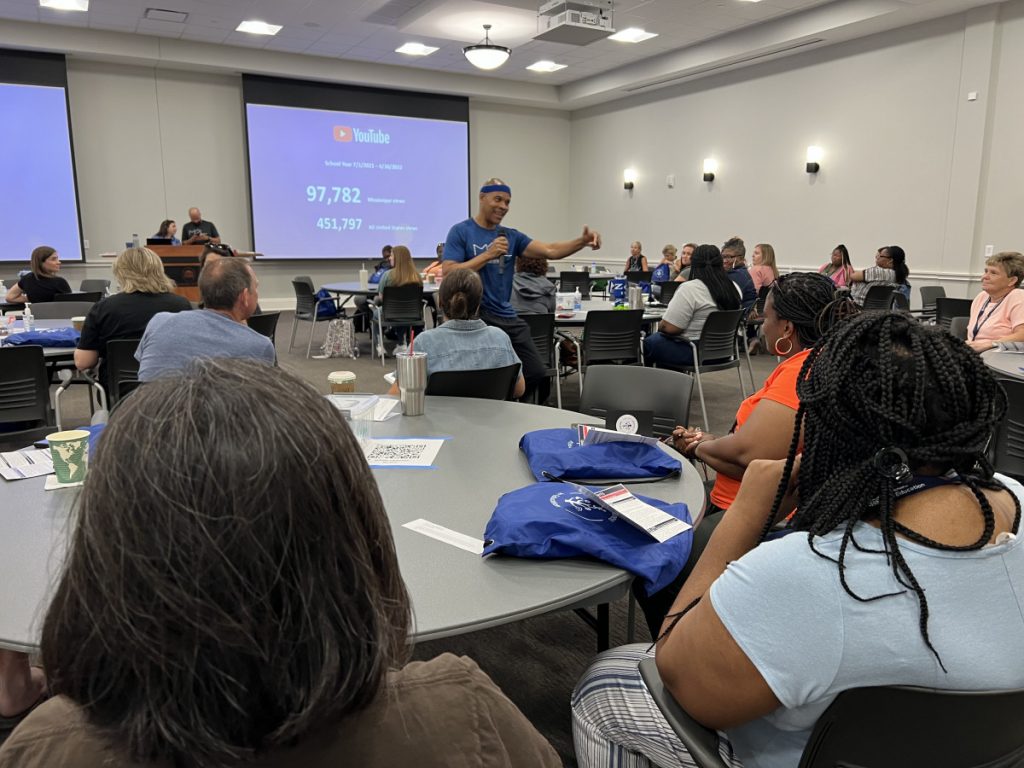Educators focused on the link between movement and academic success.
By Leslie Joblin

Image: Educators in Amber Sims’ session create a hopscotch game that incorporates phoneme exercises with jumping exercises.
What do a distracted student, a disruptive student, a sluggish student, and an underperforming student have in common? They may not be suffering from poor instruction but from inactivity or poor nutrition.
Though the connection may at first seem tenuous, “there is a direct correlation between physical and mental health and cognition, says Associate Professor Alicia Stapp. “The research says our bodies are made to move and always work best when active.”
To explore this mind-body connection, nearly 100 K-12 teachers, counselors, nurses, and school administrators from the state gathered for the Wellness in Education conference to learn how to integrate wellness into their classrooms.
Conference activities diverged greatly from traditional PE programs: no ropes, nets, or balls were involved. Instead, sessions focused on achieving student success in the academic classroom by integrating movement, meditation, and nutrition education.

Image: Educators learn “chair yoga” exercises from Deborah Jones
In one session, participants use stretches to reinforce geometry basics. Arms were folded at 90 degrees; a mountain yoga pose became an isosceles triangle. In a neighboring room, attendees brainstormed methods of integrating phoneme exercises with jumping exercises, culminating in a spelling hopscotch game.
Why does this work? Physical activity quickens blood flow and pumps oxygen-rich blood to the brain, while also boosting the brain’s dopamine and serotonin levels. As the CDC reports, these changes affect mood, focus, and attention, enabling students to think more clearly and solve problems more quickly.
Data show that exercise also improves retention and test scores.
Conference speakers addressed additional wellness opportunities like mindfulness, mental health, resilience, nutrition literacy, and integrating gardening into the classroom.
Among the speakers were 6 recent graduates of the Wellness and Physical Activity endorsement, a 12-hour credentialing program created by Stapp in 2015 for aspiring K-6 teachers. These speakers included Kaitlin Sills, Amber Sims, Jenny Kate Karr, Victoria Bamburg, Parker Connell, and Katelyn Price.

Image: Victoria Bamburg and Parker Connell discuss flexible searing.
The endorsement program has roots in the Move to Learn initiative, established in 2012 and led by “Coach” Larry Calhoun, the conference keynote speaker. Calhoun visits elementary schools across the state to motivate students to move every day and to introduce educators to movement techniques to use in their lesson plans.
In 2013, Dean David Rock was introduced to Calhoun and began to brainstorm ways to set UM students up for similar success. A grant proposal was born, and with $1.2 million in private support from the Bower Foundation in Ridgeland, Mississippi, the endorsement program was created. Both the UM program and Move 2 Learn are Bower-supported programs.
“Children’s fitness, well-being, and academic success are important priorities of The Bower Foundation,” said CEO Anne Travis. “When you exercise your body, you exercise your brain.”
Integrating movement into the K-6 curriculum can move the needle for Mississippi in more ways than one.
Mississippi has the highest rate of childhood obesity in the nation, a title it has maintained with relative consistency since 1999. Nearly half of Mississippi children are overweight or obese.
Though contributing factors are complex, inactivity is a major determinant of deleterious health effects, including obesity, hypertension, and Type 2 diabetes.

Image: Kaitlyn Sills leads a session on integrating gardening into the classroom.
Mississippi children as young as eight years old are being treated for Type II diabetes and high cholesterol; according to the University of Mississippi Medical Center (UMMC), “this was unheard of just a decade ago.” The average age of onset for Type 2 diabetes among Mississippi children is 14.
“Early childhood is truly where lifelong habits are developed and formed,” Stapp said. Studies show that habits are often solidified in children by age 9.
The good news? “We are teaching teachers how to provide children with structured and unstructured movement opportunities across the school day, giving them skills and habits that ultimately carry on with them throughout their life.”

Image: “Coach” Larry Calhoun of Move 2 Learn delivers the keynote.
